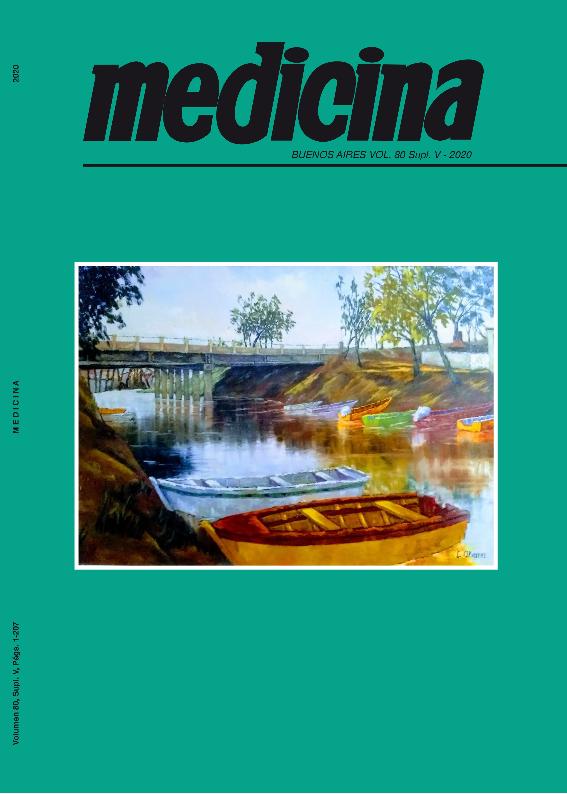Mostrar el registro sencillo del ítem
dc.contributor.author
Valenzuela Alvarez, Matias Juan Pablo

dc.contributor.author
Matos, Bruno
dc.contributor.author
Makiya, Monica
dc.contributor.author
Correa, Alejandro
dc.contributor.author
Bolontrade, Marcela Fabiana

dc.date.available
2022-03-17T18:02:32Z
dc.date.issued
2020
dc.identifier.citation
Mom is that you? Proteomic approach to assess the relationship between mesenchymal stem cells and Ewing´s sarcoma cells: tracking the cell of origin; LXIII Reunión Anual de la Sociedad Argentina de Investigación Clínica (SAIC), LXVIII Reunión Anual de la Sociedad Argentina de Inmunología (SAI), Reunión Anual de la Sociedad Argentina de Fisiología (SAFIS); Argentina; 2020; 48-48
dc.identifier.issn
0025-7680
dc.identifier.uri
http://hdl.handle.net/11336/153532
dc.description.abstract
Ewing's sarcoma (ES) is a primitive neuroectodermal tumor that mostly affects children and young adults between 5 and 30 years. Understanding the biology and mechanisms involved in ES growth and progression may lead to the identification of new therapeutic targets. Previous results from our group have shown that a functional link exists between ES and bone marrow (BM)-derived stem cells. In spite of its characterized molecular pathology, many ES development mechanistic aspects remain unknown, without a well-defined etiology, and there is a need to elucidate mechanisms associated to tumor cell survival and cancer progression. Further, markers associated to clinical progression need to be identified. Given that mesenchymal stem cells (MSC) play a central role in regulating osteogenesis and hematopoiesis, sharing functional and hierarchical relationship to ES, we undertook a proteomic analysis with a shotgun approach aimed at comparing BM-MSC and TC71 ES cells. We identified 565 proteins shared by BM-MSC and TC71 cells, while TC71 had 628 and BM-MSC 484 unique proteins. Gene ontology analysis revealed that major differences were found in metabolism pathways, with emphasis in the citric acid cycle, electron transport and ATP synthesis that may relate to the aggressiveness of the disease in terms of rapid growth and metastases development after diagnosis. We also found differences related to protein cellular distribution, with a higher percentage of mitochondrial proteins in ES cells (43,71% TC71 vs 27,86% BM-MSCs), pointing that metabolism governs major divergences in ES cells. In terms of the ES signature EWS-FLl1 translocation that leads to cluster ES tumors as rather homogeneous, further exploration on the transcriptional activity of this oncoprotein in relation to the elusive cell of origin, will lead to improve the management of this sarcoma in soft tissues other than bone, as well as to identify markers associated to progression and therapy response.
dc.format
application/pdf
dc.language.iso
eng
dc.publisher
Fundación Revista Medicina
dc.rights
info:eu-repo/semantics/openAccess
dc.rights.uri
https://creativecommons.org/licenses/by-nc-sa/2.5/ar/
dc.subject
EWING´S SARCOMA
dc.subject
MESENCHYMAL STEM CELL
dc.subject
PROTEOMICS
dc.subject
ETIOLOGY
dc.subject.classification
Otras Medicina Básica

dc.subject.classification
Medicina Básica

dc.subject.classification
CIENCIAS MÉDICAS Y DE LA SALUD

dc.title
Mom is that you? Proteomic approach to assess the relationship between mesenchymal stem cells and Ewing´s sarcoma cells: tracking the cell of origin
dc.type
info:eu-repo/semantics/publishedVersion
dc.type
info:eu-repo/semantics/conferenceObject
dc.type
info:ar-repo/semantics/documento de conferencia
dc.date.updated
2022-03-16T19:08:46Z
dc.journal.pagination
48-48
dc.journal.pais
Argentina

dc.journal.ciudad
Ciudad Autónoma de Buenos Aires
dc.description.fil
Fil: Valenzuela Alvarez, Matias Juan Pablo. Consejo Nacional de Investigaciones Cientificas y Tecnicas. Oficina de Coordinacion Administrativa Houssay. Instituto de Medicina Traslacional E Ingenieria Biomedica. - Hospital Italiano. Instituto de Medicina Traslacional E Ingenieria Biomedica. - Instituto Universitario Hospital Italiano de Buenos Aires. Instituto de Medicina Traslacional E Ingenieria Biomedica.; Argentina
dc.description.fil
Fil: Matos, Bruno. No especifíca;
dc.description.fil
Fil: Makiya, Monica. Instituto Universidad Escuela de Medicina del Hospital Italiano; Argentina
dc.description.fil
Fil: Correa, Alejandro. No especifíca;
dc.description.fil
Fil: Bolontrade, Marcela Fabiana. Consejo Nacional de Investigaciones Cientificas y Tecnicas. Oficina de Coordinacion Administrativa Houssay. Instituto de Medicina Traslacional E Ingenieria Biomedica. - Hospital Italiano. Instituto de Medicina Traslacional E Ingenieria Biomedica. - Instituto Universitario Hospital Italiano de Buenos Aires. Instituto de Medicina Traslacional E Ingenieria Biomedica.; Argentina
dc.relation.alternativeid
info:eu-repo/semantics/altIdentifier/url/https://inmunologia.org.ar/revista-medicina-2020/
dc.conicet.rol
Autor

dc.conicet.rol
Autor

dc.conicet.rol
Autor

dc.conicet.rol
Autor

dc.conicet.rol
Autor

dc.coverage
Internacional
dc.type.subtype
Reunión
dc.description.nombreEvento
LXIII Reunión Anual de la Sociedad Argentina de Investigación Clínica (SAIC), LXVIII Reunión Anual de la Sociedad Argentina de Inmunología (SAI), Reunión Anual de la Sociedad Argentina de Fisiología (SAFIS)
dc.date.evento
2020-11-10
dc.description.paisEvento
Argentina

dc.type.publicacion
Journal
dc.description.institucionOrganizadora
Sociedad Argentina de Investigación Clínica
dc.description.institucionOrganizadora
Sociedad Argentina de Inmunología
dc.description.institucionOrganizadora
Sociedad Argentina de Fisiología
dc.source.revista
Medicina (Buenos Aires)

dc.date.eventoHasta
2020-11-13
dc.type
Reunión
Archivos asociados
